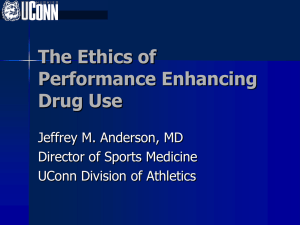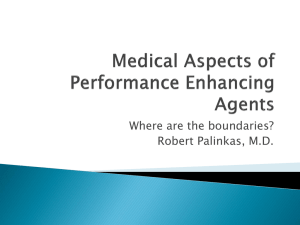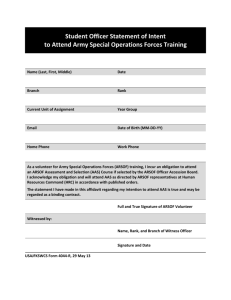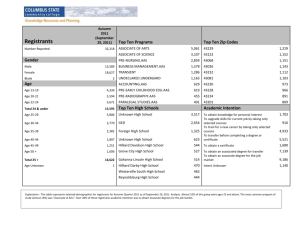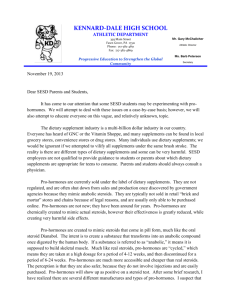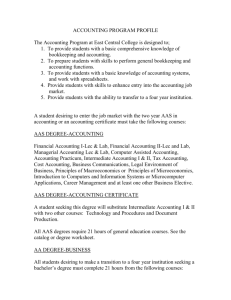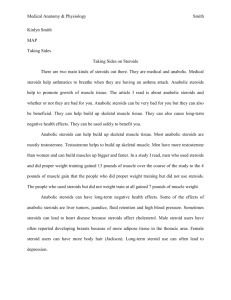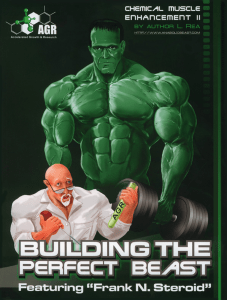Anabolic-Androgenic Steroids
advertisement
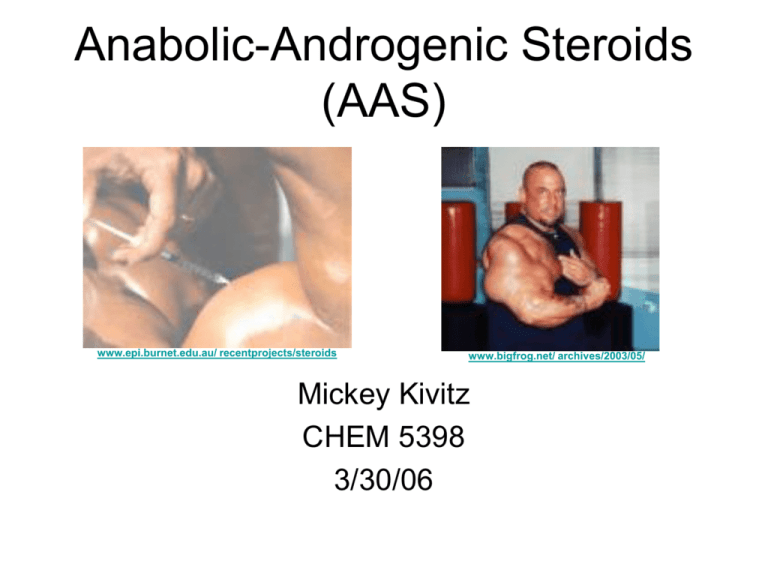
Anabolic-Androgenic Steroids (AAS) www.epi.burnet.edu.au/ recentprojects/steroids www.bigfrog.net/ archives/2003/05/ Mickey Kivitz CHEM 5398 3/30/06 What are Steroids? • Endocrine hormones: chemical signals released into the bloodstream which act upon target receptors far away from their site of release. • Produced by body and made synthetically in the lab. • Classes of Steroids – Naturally occurring • • • • Androgens Corticoids Estrogens Progestogens – Synthetic • Anabolic-Androgenic • Medicinal versus performance enhancing Definitions • Androgen: Any hormone with testosterone-like actions • Anabolism: Cellular synthesis of organic molecules (including proteins). History of AAS • Testosterone discovered in 1935 by independent European researchers (1). – All AAS are synthetic derivatives of testosterone. • Anabolic steroids initially used in medicine to treat hypogonadism – a condition in which testes produce abnormally low testosterone levels (2). • Bodybuilders and weightlifters first used anabolic steroids in 1930s to increase skeletal muscle mass (2). • Current uses: – Serving medicinal purposes (treating delayed puberty, impotence and muscle deterioration brought upon by HIV infection) (2). – Athletic manipulation and taboo. Hypogonadism • Hypogonadism in adult males may alter certain masculine physical characteristics and impair normal reproductive function. Signs and symptoms may include:・ Erectile dysfunction・Infertility・Decrease in beard and body hair growth・Increase in body fat・Decrease in size or firmness of testicles・Decrease in muscle mass・ Development of breast tissue・Loss of bone mass (osteoporosis ) Natural Steroid Derivatives: Cholesterol and Testosterone 17 carbon atoms in a 4-ringed structure. cyclopentanoperhydrophenanthrene www.people.vcu.edu/ ~urdesai/intro.htm (3) Cholesterol (4) Testosterone (4) Steroids as Hormones • The body uses hormones to maintain a stable internal environment as well as perform long-lasting communication. • Because AAS are cholesterol derivates, they are nonpolar and readily cross the plasma membrane. – However, they are insoluble in aqueous environments and require plasma protein cotransporters when circulating through blood (5). Common Steroid Hormones Cortisol (4) Aldosterone www.icgeb.org/~p450srv/ ligand/aldosterone.html (6) (4) Progesterone (4) Physiological Synthesis of Androgens • Manufacture by testis (initiated by luteinizing hormone) and adrenal cortex, and to a lesser degree by the ovaries. • Androgen Receptor (AR) exists in reproductive as well as non-reproductive tissue (i.e. skeletal muscle, etc). – Specificity of action varies based on testosterone derivative structure. – Action at tissue or organ also depends on AR quantity. For example, prostate has 25X more AR than skeletal muscle (7). AAS as Drugs • Medicinal: Therapeutic effects of testosterone replacement – Restore muscle mass in degenerative states, such as hypogonadism, HIVrelated muscle wasting conditions, sarcopenia (age-related muscle loss) (8). • Performance Enhancing Effects – Commonly selfadministered, therefore little empirical evidence. – Increased strength and body weight due to heightened skeletal muscle mass (8) – Numerous side effects. Common Anabolic Adrogenic Steroids Lacks methyl group Ester as prodrug OH CH3 OR OH H H H HO H H H O O O Nandrolone Ester (R = CH3(CH2)8CO) Testosterone Methandrostenolone (dianabol) OH CH3 H H H O Oxymetholone (androle) O OH H H O H H O O Androstenedione (Andro) Oxandrolone Androgen Receptor Binding • AR exists in multiple tissue types (4). • Binds ligand in cytoplasm and translocates into nucleus (8) • Functional domains: DNA binding domain, hinge domain and hormone binding domain. • Androgens are AR agonists and facilitate appropriate gene activation. www.molfunction.com/ tutorial.htm (9) AR-Agonist Binding Interactions • AR activity is contingent upon ligand binding, AR homodimerization and subsequent nuclear localization to activate transcription of target genes (10). – Local effects such as increased skeletal muscle mass and strength occur due to heightened ability to fixate nitrogen, facilitating protein synthesis (1), as well as erythropoiesis (production of red blood cells) (11). AR Competition: Anti-androgens • Androgen antagonists • Method of action – Suppresses testosterone activity by competing for AR binding site. • Therapeutic uses include prostate cancer, benign prostatic hyperplasia, hypersexuality and others; counteracts androgen-caused diseases (4). Cyproterone (4) Methods of AAS Use • Administration of AAS may occur through multiple routes and often in combination (stacking) (12). – Intramuscular injection, orally, and in gels or creams that are rubbed on the skin. • Self-administration is common and often occurs in a regimented pattern. (8) – User cycles may last between 4 and 12 weeks, with “off-cycles” occuring between using periods. – Athletes using AAS (doping) cycle during training and compete in the off-cycle in hopes of circumventing drug tests. • AAS may be used in combination with accessory drugs and dietary supplements to maximize results (8) Why Abuse AAS? • Most common reason: improve athletic performance. • Also, to gain rapid and substantial muscle size and/or reduce body fat in an effort to attain a desired physical appearance (12) – Reinforcement issues: in addition to initial physical gains, androgen receptors in the brain stimulate feelings of euphoria and increased aggressiveness. Additional use is perpetuated as one becomes less receptive to outside opinion and resorts to aggressive behavior to continue the cycle (1). • AAS reduce recovery time between periods of strenuous metabolic activity (8), but evidence remains minimal (13). • No proven effect on endurance or stamina (13). Side Effects of AAS • Mild – increased sexual drive, acne, increased body hair and baldness, aggressive behavior (13). • Prolonged use interferes with ability to naturally produce testosterone in the face of withdrawl (13). • Common problems of AAS due to chronic abuse also include hypertension, atherosclerosis, blood clotting, jaundice, hepatic carcinoma, tendon damage, and reduced fertility in males (11). • Severe life threatening side effects include heart attacks and liver cancer (12). Prevalence of Drug Usage • International Olympic Committee placed anabolic steroids on their list of banned substances in 1975 (11). • AAS put on list of Schedule III Controlled Substances in 1990, making it available only by prescription. However, recent studies indicate that use may be on the rise (8). • 1999 survey amongst middle school and high school students showed an increase in lifetime use by 10th graders, alongside a decrease in risk of perceived harm among high school seniors (2). Conclusion and Future • Enhancing/ understanding medical treatments – Fracture healing, soft tissue healing, postoperative rehabilitation. (8) • Efforts must be made to eradicate athletic use through education. • Long-term effects are currently under investigation, and adverse effects of AAS on cardiovascular, hepatic, endocrine/reproductive, behavioral, dermatologic systems are being studied (8). References 1. 2. 3. 4. 5. 6. 7. 8. 9. 10. 11. 12. 13. Shahidi, Nasrollah. A Review of the Chemistry, Biological Action, and Clinical Applications of Anabolic-Androgenic Steroids. Clinical Therapeutics. 2001; 23: 1355-1390. Research Report Series – Anabolic Steroid Abuse: What are anabolic steroids? National Institute on Drug Abuse website. www.people.vcu.edu/ ~urdesai/intro.htm http://en.wikipedia.org/wiki/Main_Page Norris, David O. Vertebrate Endocrinology. Philadelphia; Lea and Febiger, 1980: 284-299. www.icgeb.org/~p450srv/ ligand/aldosterone.html http://muscle.ucsd.edu/musintro/steroids.shtml Evans, Nick A. Current Concepts in Anabolic-Androgenic Steroids. The American Journal of Sports Medicine. 2004; 32 (2) 534-542. www.molfunction.com/ tutorial.htm Chen, Yen, Zajac, Jeffrey D, Maclean, Helen E. Androgen regulation of satellite cell function. Journal of Endocrinology. 2005; 186: 21-31. Mottram, DR, George, AJ. Anabolic Steroids. Bailleres Best Pract Res Clin Endocrinol Metab. 2000 Mar; 14 (1) 55-69. Research Report Series – Anabolic Steroid Abuse: Why do people abuse anabolic steroids? National Institute on Drug Abuse website. Hartgens, Fred, Kuipers, Harm. Effects of Androgenic-Anabolic Steroids in Athletes. Sports Medicine. 2004; 34 (8): 513-554.
